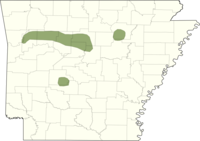Description
The queensnake is a slender, semi-⚠ aquatic snake. Arkansas specimens may reach approximately 660 mm total length. Females are typically longer and more stout than males. ⚠ Dorsal body color ranges from dark brown to slate. Yellow ventrolateral stripes are present and the ⚠ ventral surface is a cream to yellow color with four dark stripes. Scales are ⚠ keeled and the anal plate is divided.
Habitats
Queensnakes live around rocky creeks and rivers where they forage for crayfish. They are most often found under rocks near the water's edge, sometimes with other queensnakes or even with watersnakes (genus Nerodia).
Habits and Life History
Queensnakes can be found foraging for crayfish or under rocks near the water. However, they are rarely found basking in the open the way that watersnakes of the genus Nerodia do.
Females do not reach sexual maturity until their second year and may not mate until their third. Mating usually occurs in the spring with young born in August or September, but mating may occasionally take place in the fall.
Prey and Hunting Techniques
Queensnakes are feeding specialists that consume freshly molted crayfish of the genus Cambarus. Crayfish may make up over 98% of the diet of queensnakes. They will eat other prey such as snails or minnows, but this is very rare.
Temperament and Defense
Queensnakes are very docile snakes that do not bite even if picked up. However, they will thrash and emit a foul smelling musk. Their first line of defense, though, is to escape into the water.
Conservation
Currently, queensnakes are not listed as threatened or endangered in Arkansas. However, queensnakes need clean, unpolluted water to live. Eutrophication from livestock and poultry runoff may pose a threat to Arkansas populations. Also, human recreation may have adverse effects on queensnakes. Population estimates in Arkansas are limited, but queensnakes are certainly rare and may be nearing ⚠ extirpation.
State Distribution and Abundance

| Arkansas is the only state west of the Mississippi River with queensnakes. The Arkansas population is disjunct from eastern populations and, therefore, have unique genetic differences. Historically, Arkansas queensnakes inhabited parts of the Ouachita Mountains, Arkansas Valley, and Ozark Mountains. Currently, they are only known from streams that drain southward out of the Ozarks.
|
Gallery
⚠ (:flickrgallery:)
Contributors
- Jonathan W. Stanley April 05, 2006, at 10:39 AM
Bibliography
- Behler, J. L., and F. W. King. 1979 (1987). The Audubon Society Field Guide to North American Reptiles and Amphibians. 3rd ed. Alfred A. Knopf, New York. 743 pp.
- Branson, B. A., and E. C. Baker. 1974. An Ecological Study of the Queen Snake, Regina septemvittata (Say) in Kentucky. Tulane Stud. Zool. Bot. 18: 153-171.
- Conant, R. 1960. The Queen Snake, Natrix septemvittata, in the Interior Highlands of Arkansas and Missouri, with comments upon similar disjunct distributions. Proc. Acad. Nat. Sci. Philadelphia 112: 25-40.
- Conant, R., and J. T. Collins. 1998. A Field Guide to Reptiles and Amphibians of Eastern and Central North America. 3rd ed., Expanded. Houghton Mifflin Co., Boston. 616 pp.
- Ernst, C. H. 2002. Regina septemvittata Cat. Amer. Amphib. Rept. 757.1-757.5.
- Irwin, K. J. 2004. Arkansas Snake Guide. Arkansas Game and Fish Commission Pocket Guide. 50 pp.
- Trauth, S. E. 1991. Distribution, Scutellation, and Reproduction in the Queen Snake, Regina septemvittata (Serpentes: Colubridae), from Arkansas. Proceedings of the Arkansas Academy of Science 45: 103-106.
- Trauth, S. E., H. W. Robison, and M. V. Plummer. 2004. Amphibians and Reptiles of Arkansas. University of Arkansas Press, Fayetteville. 421 pp.
- Weatherby, C. A. 1974. Population Genetics of the Queen Snake, Regina septemvittata. Unpubl. Master's Thesis. Miami Univ. Oxford. 32 pp.
Discussion
< Graham's Crayfish Snake | Snake | Dekay's Brownsnake >
